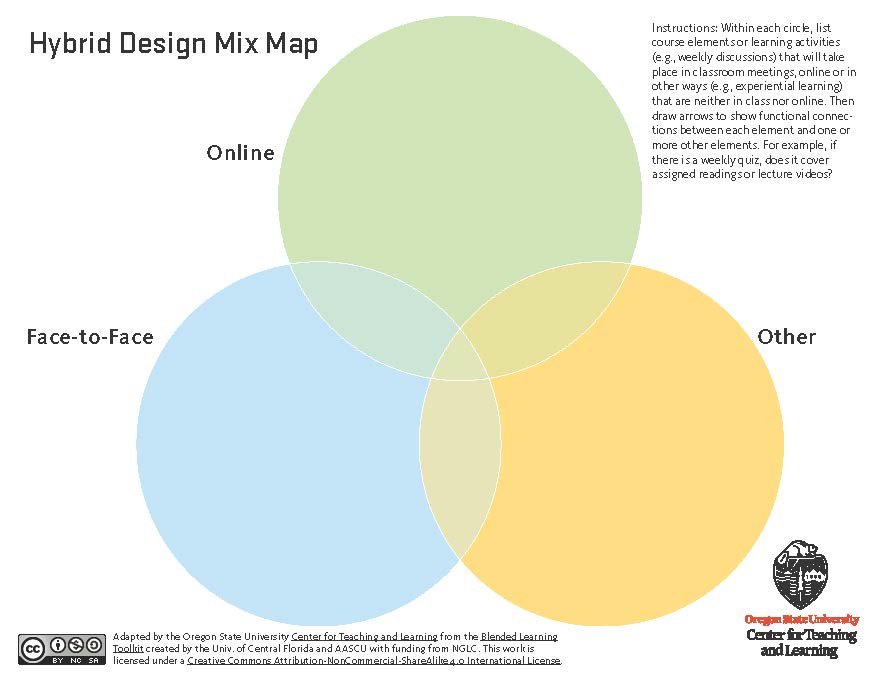As described in an earlier post, Use a Mix Map for Blended Learning, the blended learning mix map is a widely used tool to visualize and design hybrid (or “blended”) courses that integrate scheduled face-to-face meetings with online elements. The two overlapping circles in this planning template provide space to list online learning activities, face-to-face learning activities and possibly activities that occur in both learning environments.

Where Does Learning Actually Occur?
Oregon State University faculty have found utility in drafting mix maps while in the early phases of hybrid course development. Many of those faculty suggested that the traditional two-circle mix map needed one improvement, namely a third circle! In response, the Center for Teaching and Learning and Ecampus created the Three-Disc Hybrid Design Mix Map.

Does your blended course have learning activities that extend beyond the online and classroom environments (for example, service-learning, field or clinical experiences)? If so, this three-disc mix map is an ideal course planning tool. The “Other” circle is the place to list learning activities that principally take place somewhere other than the classroom and the online course site.
Sketch a Three-Disc Mix Map in Three Steps
You could create one mix map for your entire course, but many instructors prefer to focus on a single representative week of the course. There are three steps to sketching out your blended course vision on the three-disc mix map:
1 – List each learning activity in the appropriate circle. Consider these activities from the student perspective. For instance, collaborating on a group poster project, taking a quiz or making a presentation. Be sure to include “other” learning that occurs beyond the online and in-class environments. Consider the balance between learning activities in the three circles.
As to which learning activities fit where, that’s a topic to carefully consider and to converse about with your teaching colleagues as well as an instructional designer. For instance, think about the positioning of weekly discussions in your course. In terms of student learning outcomes, do discussions work best for you and your students in the classroom, online or possibly in both places? Can discussions be structured to bridge the gap between learning environments? Remember to consider how the timing of discussions will be woven into the broader, ongoing flow of blended learning in your course. And remember that classroom meeting time is finite and measured to the nearest minute in a hybrid course, so be judicious in using that time strategically!
2 – Use arrows to draw functional connections between the learning activities. For example, a weekly quiz is based on narrated online lectures, or an in-class discussion applies information from online readings. Aim to link every activity to at least one other activity. Be especially attentive to linkages between the online and face-to-face activities.
3 – List the average amount of time per week that you expect students will spend on each learning activity. For instance, two hours of reading or 90 minutes of problem solving. Check to see if the weekly total make sense in light of the Oregon State University credit hour policy, which states, “One credit is generally given for three hours per week of work in and out of class.”
Speaking of time expectations, 15 minutes is a reasonable amount of time for you to create a first draft of a mix map.
Mixing and Remixing
I recommend that you periodically revisit—and possibly redraw—your mix map, perhaps a week later, then a month later, to see how your blended course vision has evolved. A mix map is a malleable vision of a blended course at a given moment in the course design and development process; it’s not an end point. As the design and development process moves forward, remixing the map comes naturally.
In working with mix maps and more broadly with blended course design and teaching, focus on deeply interweaving the various course elements. Hybrid courses can truly be “the best of both worlds” of online and on-the-ground teaching and learning, by building on the strengths of each of these educational modalities, but only with intentional design that explicitly, and seamlessly, meshes the online, in-class and “other” elements of the course!
Resources
The OSU Hybrid Learning website provides downloadable mix map templates and sample mix maps. For more about blended learning, refer to these earlier blog posts: Blended Learning: What Do the Faculty Say? – Part 1 and Part 2, and Susan Fein’s excellent Blended Learning: What Does the Research Show?
If you’d like to take a deeper dive into blended learning, see the Blended Learning Toolkit and Kathryn Linder’s superb guide, The Blended Course Design Workbook.

